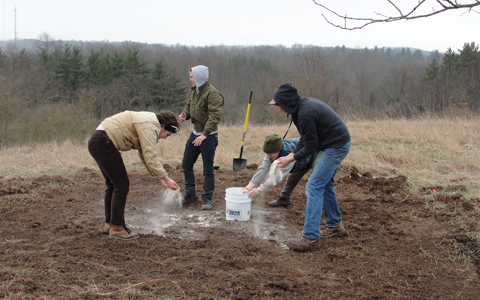By Gretchen Gregory
From Compass
Situated on the southern side of the Ohio University campus is one of Athens hidden gems, a place where students can experience research about nature through a mix of wildlife, sweeping prairie grasslands, rolling hills, forested land, valleys and ravines.
Of the 740 acres that make up the expansive Ridges property, 200 acres have been dedicated as a Land Laboratory for a quarter century, creating an environment to conduct research on wildlife habitat, grassland, biomass production and more.
“It’s more of a nature preserve or reserve that provides an opportunity for observational studies,” said Dr. Donald Miles, Professor of Biological Sciences at Ohio University and chair of the Ridges Land Laboratory Advisory Committee. “There have been experiments and long-term surveys of birds, mammals and insect habitats, genetic structure, and population dynamics. What’s unique about the property is the proximity to campus.”
Complete with nature trails and access roads that allow visitors to explore the area, the Land Lab gives researchers, students, and members of the public an opportunity to view nature within the confines of the campus and city of Athens.
Prior to becoming an official Ohio University Land Lab in 1989, the area was a workable farm used by patients of the former Athens Lunatic Asylum as part of their therapy regimen. A widely-held belief at the time was that being outdoors and working the land would improve a patient’s overall well-being and health. Patients commonly cared for cattle, chickens, mules and other livestock, as well as a fruit orchard, botanical garden, and hay field as part of therapy.
The earliest known research on the property was conducted by the late Henri Seibert, Professor Emeritus of Zoology at OHIO, who surveyed birds on the property in the 1950s.
“He was essentially doing a survey or monitoring of the area,” said Miles. “He was interested in the bird species that nested in the area, as well as the bird species that migrated through. He assembled information about when migrant birds arrived in the spring and when migrant birds departed in the fall.”
Today, there are at least 10 ongoing research projects at any given time, including a prairie grass restoration project at Radar Hill to increase the biodiversity of species once native to the area.
“The entire area of Radar Hill will be filled with flowers,” said Dr. Jared DeForest, Associate Professor of Environmental & Plant Biology. “We’re increasing the value and biodiversity of the area, and that’s one of the ways to promote Radar Hill. We want people to have a connection to the area because of the Ridges and the ongoing community involvement. This isn’t just about Ohio University, but OHIO in Athens.”
DeForest has plans to plant milkweed, big blue stems, purple coneflowers, black-eyed susans, blazing stars, butterfly weeds, compass plants, and other native plants with students.
He also has 15 soil pits within the Land Lab that are used to research the rate of soil development in the area. “The soil pits in the forest reflect how vegetation affects soil development,” he said, explaining that he uses them as a tool to teach students about different types of soil.
OHIO Assistant Professor of Ecosystem Ecology Dr. Sarah Davis is studying bioenergy production systems in 30 plots spread across two different locations within the Land Lab.
Nestled along the hillsides, Davis’ plots contain sorghum and Miscanthus X giganteus, as part of her ongoing research to determine which plants are more environmentally sustainable as bioenergy feedstocks compared to corn. “All our bioenergy in the United States is produced from corn grain, and almost half all the corn grown in the U.S. is going to ethanol production, which makes it the leading biofuel crop globally,” she said. “A lot of environmental issues surround the production of corn, but there’s the potential to grow other kinds of crops to achieve greater greenhouse gas reduction with lower environmental costs as the bioenergy industry grows.”
Miscanthus x giganteus has a higher yield than corn, requires little or no fertilizer, has an efficient system for recycling nitrogen, and pests seem to leave it alone, which eliminates the need for chemical pesticide application. “I’m convinced it is one of the better options we have as a cropping system,” she said, explaining that the perennial grew really well during her research at the University of Illinois. Now she’s conducting research to see if it does as well in the abandoned agricultural lands and clay soils found in the hills of Southeastern Ohio.
“The Land Lab is a great resource for doing research because there’s not a lot of activity out there and there is a mix of land use types,” Davis said. “By establishing these plots for agricultural research, I’m hoping other people might also become interested in studying them.”
Besides faculty and classroom experience, people outside the University also visit to conduct research. “We’ve had individuals come down from Ohio State and conduct surveys on dragonflies and damselflies, and graduate students work in the forest and cove areas,” said Miles as he stooped over along a trail near Radar Hill to pick up a piece of litter lying on the ground.
Miles, along with OHIO Environmental Engineer Cliff Hamilton, are both stewards of the land and recognize the importance of trying to keep the grounds clean and free of outside animals. “There are certain things that are incompatible with scientific research and ongoing educational work here, and dogs running free are one of the things that are incompatible with this,” Hamilton said, noting that pets are not allowed inside the Land Lab.
Miles continued along the trail and pointed out the call of an eastern towhee as it sang from within a tree along the hillside. “It’s singing ‘Drink your tea,’” he said, explaining how to recognize the bird’s song.
It’s the first lively bird call since the red-tailed hawk and turkey vulture flew from the area seconds before, Hamilton said. One-by-one, other birds followed suit and started to sing.
Miles and Hamilton are both familiar with the Land Lab, and Miles takes his ornithology class to the area at the start of fall semester. “Nobody is up here, the air is crisp, and we see wild turkeys and a lot of hawks. You wouldn’t imagine that Athens is just a little walk away,” he said. “In the mornings, we’ll walk up here and great-horned owls will be perched on the trees near the field.”
Also on the property is Cove Woods, made up of older growth trees where migrating warblers make their home while traveling from their breeding grounds in the north to their breeding grounds in the south in winter. “There’s pine that’s been planted, and we have some successional growth, old fields, shrub habitat, an heirloom apple orchard, and it’s really a mosaic of different habitat types,” said Hamilton.
About the Land Lab
The Land Lab serves as habitat to several species of trees, including oak, maple, beach, hickory, walnut, red bud, sycamore, dogwood, wild cherry, sassafras, pawpaw, tulip poplar and hackberry, as well as wildlife like white-tailed deer, red fox, raccoons, opossums, chipmunks, field mice, birds, snakes and salamanders, and more than 500 plant species.



















Comments